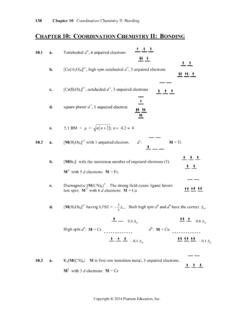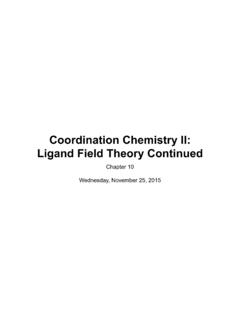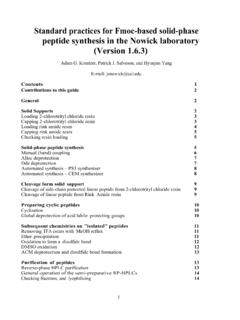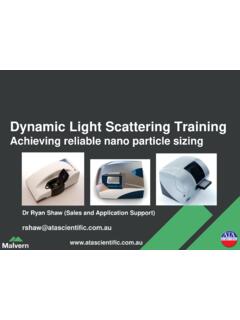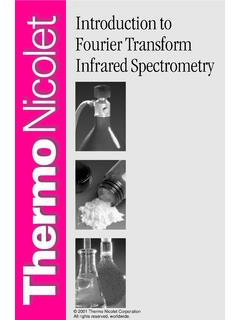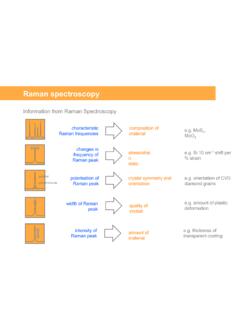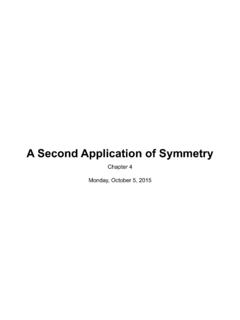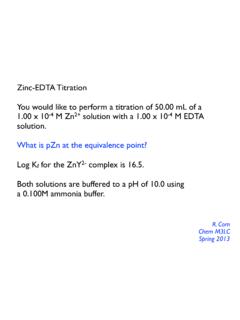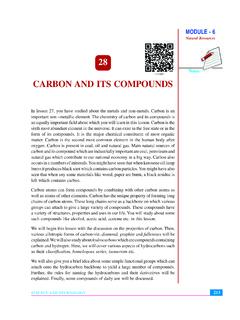Transcription of CHAPTER 6: ACID-BASE AND DONOR-ACCEPTOR CHEMISTRY
1 82 CHAPTER 6 ACID-BASE and DONOR-ACCEPTOR CHEMISTRY Copyright 2014 Pearson Education, Inc. CHAPTER 6: ACID-BASE AND DONOR-ACCEPTOR CHEMISTRY Acid Base Definition a. AlBr3 Br Lewis b. HClO4 CH3CN Lewis, Br nsted-Lowry c. Ni2+ NH3 Lewis d. ClF NH3 Lewis e. SO2 ClO3 Lewis f. HF C3H7 COOH Lewis, Br nsted-Lowry Acid Base Definition a. XeO3 OH Lewis This is not a Br nsted-Lowry reaction since the product connectivity is [XeO3(OH)] . b. Pt XeF4 Lewis c. H2 SeO4 C2H5OH Lewis, Br nsted-Lowry d. [CH3Hg(H2O)]+ SH Lewis This reaction likely occurs via the following steps: [CH3Hg(H2O)]+ SH [CH3Hg(SH)] + H2O[CH3Hg(SH)] + H2O [CH3 HgS] +H3O+ While a Br nsted-Lowry reaction occurs in the second step, the species listed in Problem are involved in the initial Lewis ACID-BASE reaction.
2 E. CH3 COOH (benzyl)3N Lewis, Br nsted-Lowry f. HCl SO2 Lewis Al3+ is acidic: [Al(H2O)6]3+ + H2O [Al(H2O)5(OH)]2+ + H3O+ The hydronium ions react with the basic bicarbonate to form CO2: H3O+ (aq) + HCO3 (aq) 2 H2O (l) + CO2 (g) With pKa values of for [Al(H2O)6]3+, for H2CO3, and for HSO4 , the pH is about 3, low enough to convert the bicarbonate to CO2. CHAPTER 6 ACID-BASE and DONOR-ACCEPTOR CHEMISTRY 83 Copyright 2014 Pearson Education, Inc. An increase in conductivity suggests that ions are formed: BrF3 + KF BrF4 + K+ a. The ions are [BrF6] and [BrF4]+: 2 Cs[BrF6] + [BrF4][Sb2F11] 3 BrF5 + 2 CsSbF6 b. [BrF6] : Oh (this complex features a stereochemically inactive nonbonding pair on the central Br atom. See A. R. Mahjoub, X. Zhang, K. Seppelt, Chem. Eur. J. 1995, 1, 261.) [BrF4]+: C2v c.
3 [BrF4]+ acts as a Lewis acid, accepting F . 2 H2SO4H3SO4+ + HSO4 and 2 H3PO4H4PO4+ + H2PO4 form enough ions to allow conductance in the pure acids. Gas-phase basicity is defined as G for BH+(g) B(g) H+(g), while proton affinity is H for the same reaction. Since G H T S, and S is undoubtedly positive for these reactions (where one mole of gaseous reactant is converted to two moles of gaseous products), it makes sense that the gas-phase basicities in Table are less positive than the corresponding proton affinities. These data suggest the following basicity ranking for these ketones: OH3 CCH3OH3CH2 CCH2CH3 OPhPh<< A convenient way to rationalize this basicity ranking is to examine the conjugate acids via resonance arguments. One resonance form features a positive charge on the carbonyl carbon (structure B, right). Since benzophenone can further delocalize this positive charge into its phenyl groups, the conjugate acid of benzophenone is the most stabilized of the three acids, leading to benzophenone being the strongest base.
4 Since an ethyl group is slightly more electron-releasing than a methyl group, the conjugate acid of diethylketone is slightly more stabilized relative to the conjugate acid of acetone (structure B is more effectively stabilized in the conjugate acid of diethylketone relative to A, the conjugate acid of acetone). Acetone is consequently the weakest base among these ketones. These data indicate that triphenylphosphine (PPh3) is more basic than triphenylamine (NPh3) in the gas phase. On the sole basis of electronics, triphenylamine would be expected to be more basic by virtue of the higher electronegativity of N relative to P, leading to the N center being more electron rich than the P center. However, the origin of the observed gas-phase basicity ranking must be the varying abilities of these atoms to accommodate the tetrahedral geometries of the conjugate acids. The larger covalent radius of P relative to N results in longer P C(phenyl) bonds than N C(phenyl) bonds, resulting in less steric strain between the phenyl rings in BrFFFF+ORRHORRHAB84 CHAPTER 6 ACID-BASE and DONOR-ACCEPTOR CHEMISTRY Copyright 2014 Pearson Education, Inc.
5 [HPPh3] relative to [HNPh3] . The conjugate acid [HPPh3] has less steric hindrance than [HNPh3] , and PPh3 is more basic. The data are graphed below. Methanol Ethanol Wa t e r Dimethylether Diethylether 650 670 690 710 730 750 770 790 810 Gas-Phase Basicity (kJ mol-1) pKa of Conjugate Acid in Water a. The gas-phase and aqueous basicity data correlate poorly. The strongest base in aqueous solution (H2O) is the weakest base in the gas phase. While basicity in water increases as Me2O < Et2O < MeOH < EtOH < H2O, the basicity in the gas-phase increases as H2O < MeOH < EtOH < Me2O < Et2O. b. The ethers are the strongest gas-phase bases within this series on the basis of the electronic impact of two electron-releasing alkyl groups bound to the oxygen atom compared to one group (ROH) or no alkyl groups (H2O). The oxygen atoms of these ethers are relatively electron rich as a result.
6 However, the ethers are the weakest bases in water of this series; their conjugate acids have fewer sites for hydrogen bonding with H2O relative to the conjugate acids of alcohols and water. The poorer ability of the conjugate acids of the ethers to be solvated by water renders these ethers very poor bases in aqueous solution. c. As shown in the graph and the basicity rankings above, the ethyl molecule is more basic than the methyl molecule in both the gas-phase and in aqueous solution. This is undoubtedly an inductive effect; the more electron-releasing ethyl group renders Et2O and EtOH more basic than Me2O and MeOH, respectively, in both phases. d. H2O is the strongest base in water of this series on the basis of the excellent ability of its conjugate acid (H3O+) to be solvated by water via hydrogen bonding . It is the weakest gas-phase base within this series as a consequence of the relatively poor inductive effect of H compared to methyl and ethyl in increasing electron density at the oxygen atom.
7 CHAPTER 6 ACID-BASE and DONOR-ACCEPTOR CHEMISTRY 85 Copyright 2014 Pearson Education, Inc. This BF3 affinity trend is strongly correlated to the inductive ability of the groups bound to sulfur. These data suggest that the electron-releasing ability of substituents in sulfoxides (R2SO) increases as R Ph Me nBu cyclo-(CH2). A resonance argument can be employed to further rationalize the relatively low BF3 affinities of Ph2SO and PhSOMe. The phenyl group permits delocalization of the formal positive charge at the oxygen in structure C (below), rendering this oxygen atom less Lewis basic than when alkyl groups which cannot enable this attenuation of the positive formal charge are present instead of phenyl groups. SOBF3 SOBF3 SOBF3 Other resonance forms with further delocalization of positive charge into phenyl ringsABC a. According the the authors, a reference acid should be a strong enough Lewis acid to react with most common bases; form 1:1 ACID-BASE adducts; have spectroscopic characteristics that can be monitored to observe variations in the strength of Lewis bases when reactions are conducted; and should not undergo side reactions while acting as a Lewis acid.
8 B. Lewis basicity towards the zinc(II) reference is governed significantly by the steric hindrance created at the nitrogen upon complexation. The bases quinuclidine and pyridine, both of which feature insignificant geometric changes at nitrogen upon binding, were found more Lewis basic than all primary, secondary, and tertiary amines examined with the zinc(II) reference. This is not the case when assessing Lewis basicity via BF3 affinities. For example, the BF3 affinity for pyridine ( kJ mol) is less than for some tertiary amines (for example, the BF3 affinity of Me3N is kJ mol). c. The importance of steric hindrance is reflected in the trends observed. When acyclic amines are considered, the less hindered primary amines were generally the strongest Lewis bases. A clear trend was not observed with secondary and tertiary amines, but secondary amines were found stronger bases than tertiary amines when bases with the same alkyl group were examined.
9 Among alicyclic amines, the trend is opposite in that quinuclidine (tertiary) was found stronger than the secondary amine piperidine. The authors state the relative order of the Lewis basicity for acyclic amines as primary > secondary > tertiary, but an inverted order for alicyclic amines ( tertiary > secondary primary (acyclic)). a. The frustrated Lewis pair of the sterically encumbered P(t-C4H9)3, in combination with the highly Lewis acidic B(C6F5)3, binds N2O to give a PNNOB linkage. b. This complex has been characterized by single crystal X-ray crystallography (figure at right). PtButButBuNNOBC6F5C6F5C6F586 CHAPTER 6 ACID-BASE and DONOR-ACCEPTOR CHEMISTRY Copyright 2014 Pearson Education, Inc. a. The reaction coordinate diagram is below. The van der Waals complex is hypothesized to be stabilized via significant pi-stacking between the aromatic rings of the borane and the secondary amine.
10 In the transition state, the B H bond has fully formed, and the proton is beginning to form a C H bond with the previously aromatic ring of the amine. The formal positive charge of the hydrogenated intermediate (not shown on the ispo carbon of the amine) is stabilized by resonance. NtBuPhHBC6F5C6F5C6F5H2 Frustrated Lewis Pair and Hydrogen ( kcal/mol)BC6F5C6F5 FFFFFNHtBuHHvan der Waals complex ( kcal/mol) kcal/molBC6F5C6F5 FFFFFNHtBuHHHH ydrogenated Intermediate ( kcal/mol)[(C5H11)(tBu)NH2][HB(C6F5)3][Ph (tBu)NH2][HB(C6F5)3]( kcal/mol)(Relative energy unspecified) b. As proposed in the reference, the phenyl ring of the amine in the van der Waals complex rotates towards the boron atom. The hydrogen molecule is then split in this cavity formed by the borane and the phenyl ring of the secondary amine. The hydride bonds to the boron, and the proton binds to the para carbon of the amine phenyl ring.
